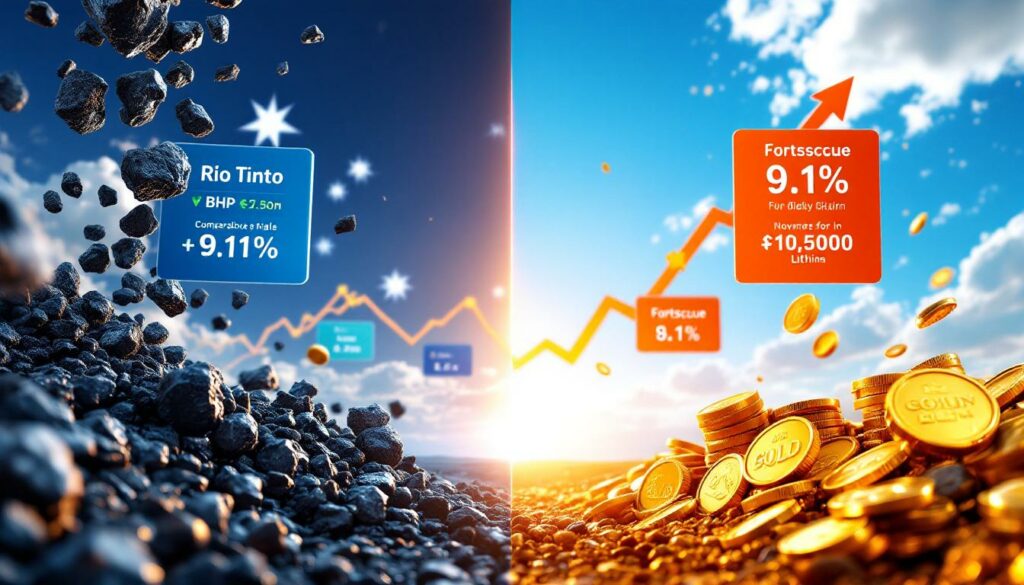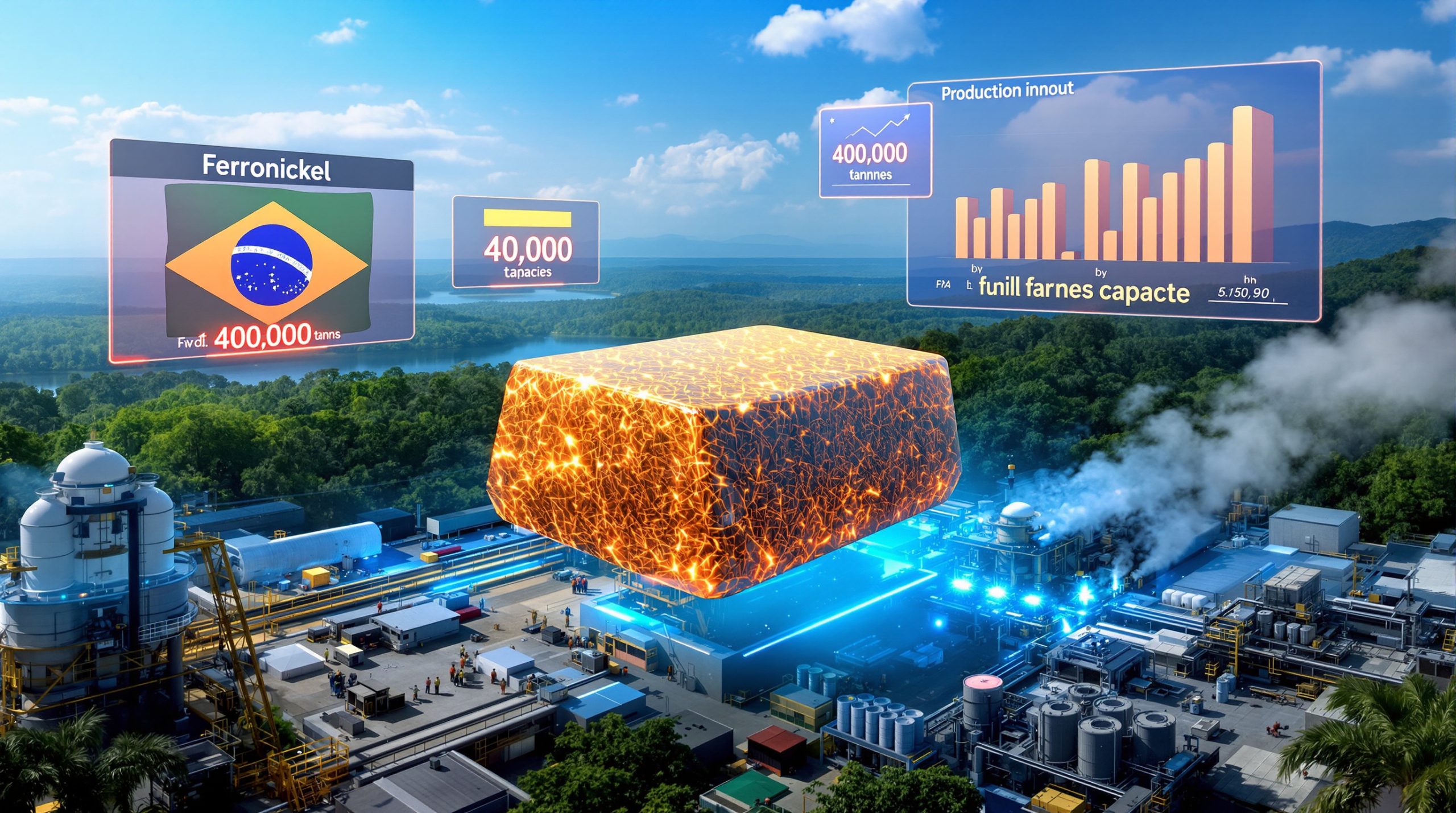How Did Australia's Mining Titans Perform in a Challenging Year?
The 2025 financial year presented significant headwinds for Australia's major mining companies amid global economic uncertainty and commodity market volatility. With iron ore price trends experiencing a substantial decline of approximately 13% year-over-year to around US$95 per tonne (a nine-month low), investors in BHP, Rio Tinto, and Fortescue faced challenging conditions throughout the fiscal period.
While the broader S&P/ASX 200 Materials Index fell by 6% during FY25, individual mining giants showed varying degrees of resilience in this difficult environment. The divergent performance among these companies highlights the importance of diversification strategies and exposure to different commodity markets.
Why Iron Ore Prices Declined in FY25
The primary driver behind the mining sector's challenges was the continued weakness in iron ore prices, which fell to a nine-month low by year-end. Several key factors contributed to this decline:
- China's economic slowdown: The world's largest iron ore consumer experienced continued growth deceleration, with GDP growth falling below government targets
- Property sector contraction: China's real estate market, which accounts for approximately 30-35% of steel consumption, saw development activity decline by over 15%
- Steel production cuts: Environmental restrictions and overcapacity concerns led to mandated production cuts across several Chinese provinces
- Global recessionary fears: Broader economic uncertainty dampened demand forecasts across commodity markets
- Supply-side pressure: Brazilian iron ore giant Vale increased production by 8% year-over-year, adding to global supply
"The iron ore market faced a perfect storm in FY25—weakening Chinese demand coinciding with robust supply from major producers created significant downward pressure on prices," noted industry analysts at the Department of Industry, Science and Resources in their June 2025 quarterly report.
This challenging price environment created a difficult backdrop for Australia's iron ore producers, though the impact varied significantly based on each company's diversification strategy and cost structure.
How Did Share Prices Perform in FY25?
The share price performance of Australia's three mining giants reflected both the broader market challenges and each company's individual exposure to iron ore price volatility. While all three experienced share price declines, the magnitude varied considerably.
Rio Tinto: The Relative Winner on Share Price
Rio Tinto shares demonstrated the most resilience among the three mining giants:
- Started FY25 at $119.00 per share
- Ended FY25 at $107.13 per share
- Overall decline: 10%
- 52-week high: $132.45 (August 2024)
- 52-week low: $101.20 (May 2025)
Rio's relatively stronger performance can be attributed to its more balanced commodity portfolio, with significant copper and aluminum assets complementing its iron ore operations. The company's strategic acquisition of Arcadium Lithium in 2024 also positioned it favorably in the battery metals opportunities space, providing some insulation against iron ore price weakness.
BHP: Middle-of-the-Pack Performance
BHP shares experienced a steeper decline than Rio Tinto but outperformed Fortescue:
- Started FY25 at $42.68 per share
- Ended FY25 at $36.75 per share
- Overall decline: 14%
- 52-week high: $45.32 (July 2024)
- 52-week low: $35.10 (June 2025)
BHP's performance reflects its position as a diversified miner with significant copper exposure through assets like Escondida in Chile. However, the company's substantial iron ore operations in Western Australia's Pilbara region meant it couldn't fully escape the sector's headwinds.
Fortescue: The Steepest Decline
Fortescue shareholders faced the most significant share price deterioration:
- Started FY25 at $21.41 per share
- Ended FY25 at $15.28 per share
- Overall decline: 29%
- 52-week high: $23.15 (August 2024)
- 52-week low: $14.75 (June 2025)
Fortescue's higher volatility (beta coefficient of approximately 1.6 compared to BHP's 0.9) and greater dependence on iron ore revenues made it particularly vulnerable to price declines in this commodity. The company's shares experienced their most significant sell-off in September 2024, when iron ore briefly dipped below $90 per tonne.
Despite ambitious green energy initiatives under its Fortescue Future Industries division, investors remained primarily focused on the company's core iron ore business performance throughout FY25.
Which Miner Offered the Best Dividend Returns?
While share prices declined across all three miners, dividend payments remained significant, providing an important offset to capital losses for investors. The miners' ability to maintain substantial dividend payouts despite challenging market conditions underscores the robust cash generation capability of their operations, even during commodity price downturns.
Comparing Total Dividend Payments
All three major miners maintained their commitment to shareholder returns through substantial dividend payments:
Rio Tinto:
- September 2024 interim dividend: $2.6170 per share
- April 2025 final dividend: $3.7132 per share
- Total FY25 dividends: $6.33 per share (fully franked)
- Dividend payout ratio: 65% of underlying earnings
BHP:
- October 2024 final dividend: $1.1099 per share
- March 2025 interim dividend: $0.7909 per share
- Total FY25 dividends: $1.90 per share (fully franked)
- Dividend payout ratio: 60% of underlying earnings
Fortescue:
- September 2024 final dividend: $0.89 per share
- March 2025 interim dividend: $0.50 per share
- Total FY25 dividends: $1.39 per share (fully franked)
- Dividend payout ratio: 78% of underlying earnings
It's worth noting that Fortescue maintains the highest payout ratio among the three miners, reflecting the company's longstanding commitment to returning a substantial portion of profits to shareholders. This policy has been championed by founder and Executive Chairman Andrew Forrest, who has consistently advocated for strong shareholder returns.
Trailing Dividend Yields: The True Comparison
When calculating trailing dividend yields based on June 30, 2025 closing prices, a different picture emerges:
| Company | Trailing Dividend Yield | Yield Including Franking Benefits |
|---|---|---|
| Fortescue | 9.1% | 13.0% |
| Rio Tinto | 5.9% | 8.4% |
| BHP | 5.2% | 7.4% |
Fortescue emerged as the clear winner in terms of dividend yield, despite experiencing the steepest share price decline. For Australian investors, the fully franked nature of these dividends provides additional value through franking credits, effectively increasing the after-tax return.
However, dividend sustainability remains a concern, particularly for Fortescue. Historical patterns suggest that when iron ore prices have fallen below $80 per tonne for extended periods, as occurred in 2023, dividend cuts have typically followed. Analysts at Goldman Sachs project Fortescue's yield could moderate to around 7.5% in FY26 if iron ore prices continue their downward trajectory.
What Factors Influenced Mining Performance in FY25?
Several key factors shaped the performance of Australia's mining giants throughout the fiscal year, with diversification strategies and commodity exposure playing crucial roles in determining relative outcomes.
Diversification Strategies
All three miners have been working to diversify beyond iron ore, though with different approaches and varying degrees of success:
-
BHP:
- Significant investments in copper mining operations, including the expansion of Olympic Dam in South Australia and the Oak Dam exploration project
- Continued development of the Jansen potash project in Canada, scheduled for first production in 2027
- Strategic divestment of thermal coal assets to reduce carbon exposure
- Iron ore contribution to revenue reduced to approximately 48% (down from 56% in FY22)
-
Rio Tinto:
- Strategic focus on copper and lithium opportunities
- Successful completion of the Oyu Tolgoi underground expansion in Mongolia, significantly boosting copper production
- Acquisition of Arcadium Lithium, providing exposure to the growing battery metals market
- Iron ore contribution to revenue at approximately 52% (down from 59% in FY22)
-
Fortescue:
- Continued heavy reliance on iron ore with over 80% of revenue derived from this single commodity
- Ambitious green energy initiatives through Fortescue Future Industries (FFI), though these remain largely pre-revenue
- Delays in key hydrogen projects impacted investor confidence in diversification timeline
- Iron ore contribution to revenue remaining stable at approximately 85%
Impact of Iron Ore Dependency
Despite diversification efforts, iron ore remains the dominant product for all three companies, though to varying degrees:
| Company | Iron Ore Revenue Contribution | Average Production Cost | Break-even Price |
|---|---|---|---|
| Fortescue | ~85% | $15.30/t | ~$45/t |
| Rio Tinto | ~52% | $18.70/t | ~$35/t |
| BHP | ~48% | $14.80/t | ~$30/t |
"Fortescue's higher dependency on iron ore magnified the impact of price volatility on both earnings and share price performance," noted mining analyst Bronwyn Allen. "While the company's cost position remains competitive, its revenue stream lacks the diversification buffers that benefited Rio Tinto and BHP."
Fortescue's lower-grade iron ore (typically 58-62% Fe compared to the benchmark 62% Fe) also meant its realized prices averaged 5-10% below the benchmark throughout FY25, further impacting margins compared to its peers.
What's the Outlook for FY26?
Looking ahead to FY26, several factors will likely influence the performance of Australia's mining giants, with government projections and company-specific strategies pointing to continued challenges but also potential opportunities.
Government Projections
The Australian Government's Department of Industry, Science and Resources has adjusted its export earnings forecasts in its June 2025 Resources and Energy Quarterly report:
- Iron ore price projections for FY26 lowered to a range of $85-90 per tonne (average)
- Overall resource export earnings expected to decline by 6.8% year-over-year
- Chinese steel production forecast to remain flat or decline slightly in 2026
- Copper prices projected to strengthen to $11,000-12,000 per tonne on supply constraints
These projections suggest continued headwinds for iron ore-focused miners, though diversified producers with copper exposure may benefit from strengthening prices in that commodity.
Strategic Positioning
Each company is positioned differently for future challenges and opportunities:
-
BHP:
- Copper investments, particularly the ramp-up of production at the expanded Spence operation in Chile, may provide a significant buffer against iron ore volatility
- The company's industry-leading iron ore production costs (averaging $14.80 per tonne) provide substantial margin protection even at lower price points
- Potash diversification through the Jansen project represents a long-term growth vector into agricultural markets
-
Rio Tinto:
- Balanced approach with copper production from Oyu Tolgoi and lithium exposure through Arcadium
- The Simandou iron ore project in Guinea (expected online in late 2026) will potentially reshape the global iron ore cost curve
- Aluminum division benefiting from lower energy costs and increased focus on low-carbon products
-
Fortescue:
- Higher dividend yield but greater exposure to iron ore price fluctuations
- FFI's green hydrogen and green steel initiatives require substantial capital investment before generating meaningful returns
- Iron ore cost position remains competitive but pressure on lower-grade products may increase if Chinese steel mills prioritize higher-grade ores for environmental reasons
"We expect the diversification initiatives at BHP and Rio Tinto to begin yielding more tangible benefits in FY26, while Fortescue faces the challenge of maintaining shareholder returns while funding its green energy transition," according to the Department of Industry's quarterly assessment.
Market consensus suggests that while all three miners may face continued share price pressure if iron ore weakness persists, Rio Tinto and BHP appear better positioned to weather these challenges due to their more diversified revenue streams.
Which Mining Stock Delivered the Best Overall Returns?
When assessing the complete financial picture for investors, we must consider both share price movements and dividend returns to determine which mining stock delivered the best overall performance in FY25.
Total Return Comparison (Share Price Movement + Dividends)
The following table combines share price change with dividend returns to calculate the approximate total return for each company:
| Company | Share Price Change | Dividend Yield | Approximate Total Return |
|---|---|---|---|
| Rio Tinto | -10% | 5.9% | -4.1% |
| BHP | -14% | 5.2% | -8.8% |
| Fortescue | -29% | 9.1% | -19.9% |
Rio Tinto delivered the best overall returns to shareholders in FY25, with the smallest negative total return of approximately -4.1%. This outperformance relative to the S&P/ASX 200 Materials Index (which declined 6% over the same period) highlights the value of Rio's more diversified commodity portfolio.
When factoring in the benefit of franking credits for Australian taxpayers, the adjusted returns improve further:
| Company | Total Return | Return Including Franking Benefits |
|---|---|---|
| Rio Tinto | -4.1% | -1.6% |
| BHP | -8.8% | -6.6% |
| Fortescue | -19.9% | -16.0% |
While all three miners delivered negative total returns for the fiscal year, Rio Tinto's performance was notably stronger, coming close to breaking even when accounting for franking benefits. This outcome underscores the value of the company's balanced exposure across iron ore, copper, aluminum, and lithium.
Key Investment Takeaways from FY25 Mining Performance
The divergent performance of Australia's mining giants in FY25 offers several important lessons for investors considering exposure to this sector.
What Investors Should Consider
-
Diversification matters: Rio Tinto's more balanced commodity exposure helped limit losses compared to more concentrated peers. The company's strategic investments in copper and lithium provided partial insulation against iron ore price declines.
-
Dividend yields can offset share price declines: High yields helped cushion the impact of price drops, particularly for Fortescue shareholders. However, investors should remember that historically, these dividends have proven vulnerable to sustained commodity prices impact weakness.
-
Iron ore dependency remains a risk factor: Companies with higher iron ore exposure faced steeper declines. Fortescue's greater concentration in this single commodity resulted in significantly higher share price volatility.
-
Cost position is crucial: Lower-cost producers like BHP maintain profitability even during price downturns. With production costs averaging $14.80 per tonne, BHP's iron ore operations generate positive cash flow even at prices well below current levels.
-
Future outlook requires caution: Government projections suggest continued challenges for iron ore prices. The Australian Department of Industry's forecast of $85-90 per tonne for FY26 indicates potential ongoing pressure for all three miners.
"The performance gap between diversified miners and iron ore specialists widened significantly in FY25," observed Allen. "This trend may continue if commodity markets remain volatile, favoring companies with exposure to multiple growth markets."
Questions for Potential Mining Investors
-
China's economic trajectory: How will China's economic policies and property market recovery efforts affect iron ore demand in FY26? Recent stimulus measures targeting infrastructure could provide some support, but structural changes in the property sector may limit the upside.
-
Diversification payoff: Will diversification strategies pay off for BHP and Rio Tinto? Copper price forecasts suggest these investments may deliver stronger returns in coming years, particularly as energy transition accelerates global demand.
-
Dividend sustainability: Can Fortescue maintain its high dividend yield if iron ore prices continue to decline? Historical patterns suggest payout ratios may need to be reduced if prices fall below $80 per tonne for an extended period.
-
Green energy investments: How might Fortescue's substantial investments in hydrogen and green steel affect near-term shareholder returns? These initiatives require significant capital expenditure before generating meaningful revenue.
-
Geological considerations: How will declining ore grades at aging mines impact production costs and competitiveness? BHP and Rio Tinto have both acknowledged the challenge of maintaining ore quality as mines mature.
FAQs About Mining Stock Returns in FY25
Why did Fortescue shares decline more than BHP and Rio Tinto?
Fortescue has greater exposure to iron ore price fluctuations due to its business model being more concentrated in this single commodity, making it more vulnerable
Want to Catch the Next Big Mining Discovery Before the Market?
Stay ahead of the market with Discovery Alert's proprietary Discovery IQ model, which instantly notifies you of significant ASX mineral discoveries, helping you identify actionable opportunities before they become mainstream news. Explore historic returns from major discoveries and start your 30-day free trial at Discovery Alert's discoveries page today.




